A) I
B) II
C) III
D) IV
E) V
Correct Answer

verified
Correct Answer
verified
Multiple Choice
Which of the following compounds has the longest max? 
A) I
B) II
C) III
D) IV
Correct Answer

verified
Correct Answer
verified
Essay
Predict the product for the following Claisen rearrangement and provide the curved arrow mechanism for formation of the product. 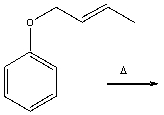
Correct Answer

verified
Correct Answer
verified
Essay
Which diene and dienophile would react to give the following Diels-Alder product? 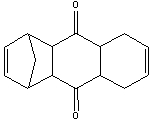
Correct Answer

verified
Correct Answer
verified
Essay
Which diene and dienophile would react to give the following Diels-Alder product? 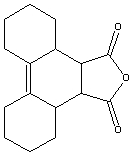
Correct Answer

verified
Correct Answer
verified
Short Answer
Use Woodward-Fieser rules to estimate the max for the following compound. 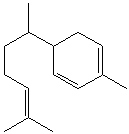
Correct Answer

verified
Correct Answer
verified
Essay
Predict the major product for the following Diels-Alder reaction. 
Correct Answer

verified
Correct Answer
verified
Multiple Choice
Which of the following compounds is (are) a cumulated diene(s) ?
A) 4-methyl-1,3-heptadiene
B) 3-methyl-1,5-heptadiene
C) 2-methyl-2,4-heptadiene
D) 4-methyl-1,4-heptadiene
E) 5-methyl-2,3-heptadiene
Correct Answer

verified
Correct Answer
verified
Multiple Choice
The following diene does not undergo Diels Alder reaction because _____. 
A) it does not have an electron donating group
B) it does not have an electron withdrawing group
C) the bicyclic ring does not function as a diene
D) it cannot adopt the s-cis conformation
E) the double bonds are not in the same cyclic ring
Correct Answer

verified
Correct Answer
verified
Essay
Which diene and dienophile would react to give the following Diels-Alder product? 
Correct Answer

verified
Correct Answer
verified
Multiple Choice
Which major product(s) are formed for the following reaction? 

A) I & V
B) II & IV
C) III & IV
D) I, III & VI
E) II, IV & V
Correct Answer

verified
Correct Answer
verified
Essay
Which diene and dienophile would react to give the following Diels-Alder product? 
Correct Answer

verified
Correct Answer
verified
Multiple Choice
Which of the following dienes can undergo the Diels-Alder reaction? 
A) I
B) II
C) III
D) IV
E) All of the these
Correct Answer

verified
Correct Answer
verified
Multiple Choice
Which one of the following represents the HOMO of 1,3,5-hexatriene? 
A) I
B) II
C) III
D) IV
E) V
Correct Answer

verified
Correct Answer
verified
Essay
Predict the possible products for the following reaction and provide a curved arrow mechanism for the formation of these products. 
Correct Answer

verified
Correct Answer
verified
Short Answer
Rank the following dienes in order of decreasing heat of hydrogenation (highest to lowest). 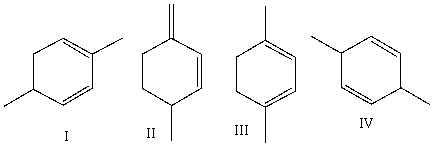
Correct Answer

verified
Correct Answer
verified
Essay
Classify the following compounds as having cumulated, conjugated or isolated double bonds? 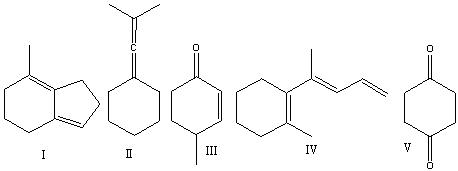
Correct Answer

verified
I. CONJUGATED
II. cu...View Answer
Show Answer
Correct Answer
verified
II. cu...
View Answer
Short Answer
What is the IUPAC name for the following compound? 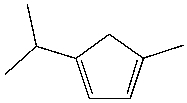
Correct Answer

verified
1-isopropy...View Answer
Show Answer
Correct Answer
verified
View Answer
Multiple Choice
Rank the indicted C-C bonds in increasing order of bond length (shortest to longest) 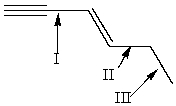
A) III<II<I
B) II<I<III
C) I<II<III
D) I<III<II
E) II<III<I
Correct Answer

verified
Correct Answer
verified
Multiple Choice
Dienes with bonds separated by two or more bonds are classified as ______.
A) isolated
B) cumulated
C) skipped
D) conjugated
E) none of these
Correct Answer

verified
Correct Answer
verified
Showing 21 - 40 of 131
Related Exams